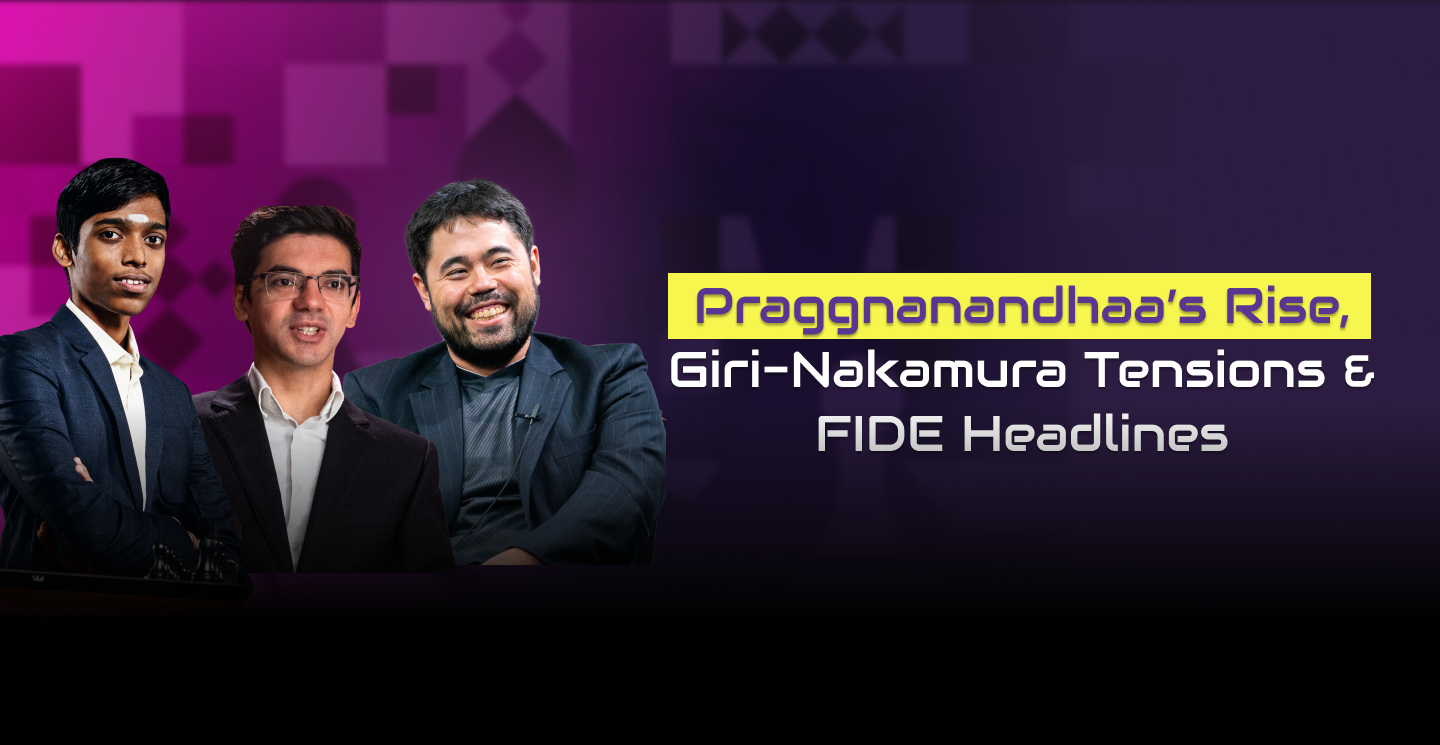Praggnanandhaa’s Rise, Giri-Nakamura Tensions & FIDE Headlines
The chess world is buzzing with seismic developments – from R Praggnanandhaa’s ascendancy to India’s No. 1 live classical ranking, to brewing rivalries among elite players, and FIDE’s latest high-profile decisions. This mid-year roundup highlights key shifts in leadership, governance, and narrative that are reshaping global chess.
Praggnanandhaa Becomes India No. 1, Acknowledges Anand’s Support
In the latest live FIDE ratings, 19-year-old R Praggnanandhaa has surpassed reigning world champion D Gukesh and Arjun Erigaisi to claim the top spot among Indian classical players, with a rating of approximately 2778.3. Gukesh now sits at No. 5 (2776.6), while Erigaisi is in sixth (2775.7).
The milestone came following Praggnanandhaa’s celebrated triumph at the UzChess Cup Masters in Tashkent. He publicly thanked mentor and legend Viswanathan Anand, thanking him for constant encouragement: “Thank you so much, Sir! This one felt special – it means a lot coming from you”.
This trio of Indians now occupies three of the world’s top-six live slots – a historic testament to India’s strength and depth in elite chess. It also positions Praggnanandhaa (world No. 4) within striking distance of future Candidates qualification and championship contention in 2026.
FIDE Issues Statement on Kramnik–Navara Dispute
FIDE has released a formal statement regarding a long-standing controversy between Vladimir Kramnik and David Navara. The issue, originally stemming from Kramnik’s disputed behavior during a team match, reignited earlier this year. In response, FIDE emphasized its commitment to sporting integrity, reiterating guidelines on conduct, anti-cheating protocols, and arbitration procedures for future disputes between elite players.
While details remain limited, the situation highlights the increasing importance of regulation and governance within top-level chess – and FIDE’s role in maintaining fairness and credibility across the global circuit.
Giri Calls Out Nakamura and Nepomniachtchi Amid Tensions
In recent interviews, Dutch Grandmaster Anish Giri has reignited a rivalry with Hikaru Nakamura and Ian Nepomniachtchi. Giri claimed the three have “so much bad blood,” referencing both over-the-board history and backstage frictions. He hinted that these tensions could impact the integrity of future team and match events, suggesting deeper fissures in the professional elite chess community.
The comments have stirred discussion in chess circles, especially since Giri is reportedly being considered for a leadership role within FIDE governance. It raises the question: Can the sport’s most public competitors also function as its administrators?
FIDE Women’s World Cup Set for Global Spotlight
FIDE has released full details for its upcoming Women’s World Cup: a knockout-format event featuring 64 top-rated players from around the world, scheduled later in 2025. Matches will cover rapid tiebreakers to classical time controls, with a direct Candidate Tournament spot for the champion.
This tournament is key to FIDE’s efforts to elevate women’s competition globally and offer an equalized path toward the women’s championship cycle. It reflects the growing emphasis on inclusive formats and expanded representation in elite arenas.
Nine-Year-Old Indian Prodigy Holds Carlsen to Draw
Aarit Kapil, a nine-year-old chess prodigy from Delhi’s Mayur Vihar, captivated the world by nearly defeating Magnus Carlsen in a blitz online game. Kapoor held Carlsen to a draw in a tense, time-pressured board, despite Carlsen being decisively winning before a time scramble leveled the score.
Aarit, who began playing just four years ago, dedicates 5–6 hours daily and trains under IM Vishal Sareen. At only a fifth grader, he already ranks among the youngest to draw Carlsen and symbolizes India’s next wave of potential future stars.
The chess world in mid‑2025 is shaped by shifts in ranking hierarchy, rising admin tensions, upcoming women’s competitions, and emergent prodigious talent. Praggnanandhaa’s milestone performance and gratitude toward Anand highlight the passing of a torch. Meanwhile, friction among grandmasters and controversies requiring FIDE oversight reflect deeper governance challenges.
Through it all, the sport continues to evolve – not only as a battleground of kings and queens, but as a community grappling with legacy, leadership, and youth rising to its promise. The Global Chess League will continue chronicling these stories, tracing how chess thrives on rivalry, reinvention, and inspiration worldwide.






